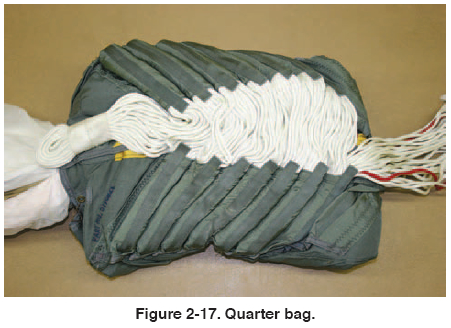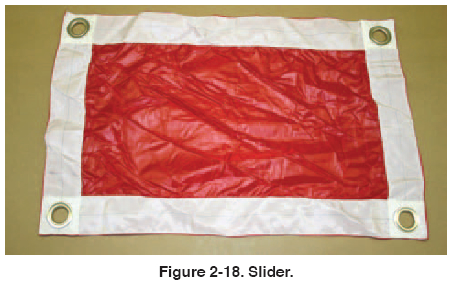Chapter 2
BRIDLES AND DEPLOYMENT DEVICES
In the early days of parachutes, the lines and canopy were
stowed in the container. During the deployment process,
the canopy was extracted first, followed by the lines. This
was known as a “canopy first” deployment. If the canopy
inflated before tension was applied to the lines, a malfunction
was highly likely. Over the years, it was learned
that the deployment process needed to be controlled to
prevent malfunctions.
At the start of the Second World War, with the advent of
airborne paratroops, the main canopy was deployed from
a direct bag static line system. In this system, the main
canopy was packed in a bag, which was permanently
attached to the static line. After deployment, the bag and
static line remained with the aircraft. This system is still
used today with some modifications. For emergency parachutes,
the military adopted the “quarter bag” in the
1950s for use with high-speed emergency systems.
[Figure 2-17] This was fairly complicated to pack but
effective in controlling the parachute during opening.

In the early 1960s, the sleeve was developed and soon
became popular for sport parachuting or skydiving. With
the growth of skydiving and the increased use of the
reserve parachute, it soon became obvious that the reserve
parachute needed to be controlled more. In the mid 1970s,
the two-stow diaper was developed for use with emergency
and reserve parachutes. This design was soon followed
by the three-stow diaper and the piglet-style diaper
invented by Hank Ascuitto. During this time period, the
deployment bag became the preferred method of deploying
the increasingly popular ram-air or square canopies.
In 1977, Para-Flite, Inc., introduced the first ram-air
reserve canopy, which utilized the “free bag” deployment
system. This design continues to this day virtually
unchanged as the preferred method of deploying square
reserve canopies.
Reefing devices slow down and stage the opening
sequences of canopies, resulting in lower opening forces.
This is particularly critical at higher speeds where the
excessive “G” forces experienced may injure or kill the
user. The most common reefing device used today is the
“slider.” [Figure 2-18] This device consists of a piece of
fabric with grommets or rings at the corners through
which the line groups pass. This restricts the inflation of
the canopy and slows down the opening. While other
methods have been developed for military or aerospace
applications, the slider is the preferred method of reefing
ram-air canopies. Without this device, skydiving would
not be as developed as it is today.

| 
